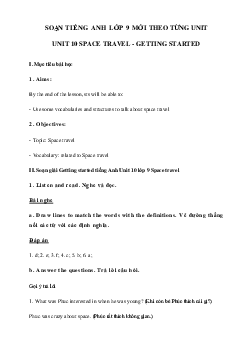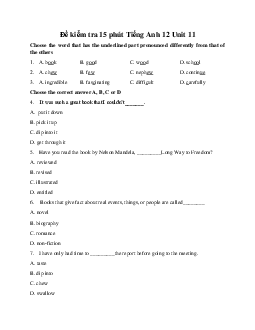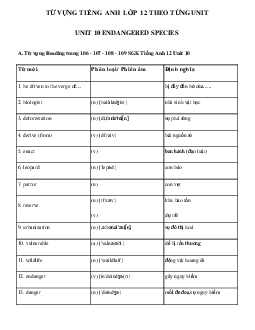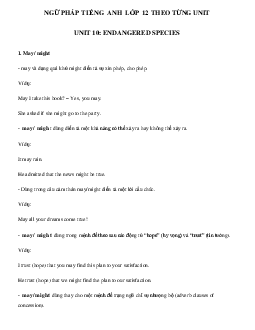











Preview text:
GIẢI SGK TIẾNG ANH LỚP 12 THEO TỪNG UNIT
UNIT 10: ENDANGERED SPECIES
A. Reading (Trang 106-107-108-109 SGK Tiếng Anh 12)
Before you read (Trước khi bạn đọc)
Work in pairs. Look at the pictures and answer the questions. (Làm việc theo cặp. Nhìn vào các bức
tranh và trả lời các câu hỏi.) a) tortoise: rùa b) rhinoceros: tê giác c) monkey: con khỉ d) elephants: con voi e) leopard: con báo f) frog: ếch nhái g) mosquito: muỗi h) parrot: con vẹt
1. Which of the animals and insects below can be found in Vietnam? (Loài động vật và côn trùng nào
dưới đây có thể tìm thấy ở Việt Nam?)
=> All of these animals and insects except for leopards can be found in Vietnam.
2. Which of them is/are in danger of becoming extinct?(Loài nào trong số chúng đang có nguy cơ tuyệt chủng?)
=> I think rhinoceros is in danger of extinction.
While you read (Trong khi bạn đọc)
Read the text then do the tasks that follow. (Đọc đoạn văn sau đó làm bài tập theo sau.) Hướng dẫn dịch:
Các loài đang gặp nguy hiểm là các loài động thực vật đang có nguy cơ bị tuyệt chủng.
Hơn 8 300 loài thực vật và 7 200 loài động vật trên trái đất có nguy cơ tuyệt chủng, và
thêm hàng ngàn loài bị tuyệt chủng mỗi năm trước khi các nhà sinh vật học có thể nhận biết chúng.
Nguyên nhân chủ yếu gây tuyệt chủng các giống loài là do sự tàn phá môi trường sống,
việc khai thác nhằm mục đích thương mại và sự ô nhiễm. Việc tháo nước khỏi các vùng
đầm lầy, nạn phá rừng, sự đô thị hóa cùng việc xây dựng đường sá và đập nước đã hủy
hoại hoặc làm tổn hại nghiêm trọng môi trường tự nhiên. Từ đầu thế kỷ 17, việc săn bắn
động vật làm thực phẩm và các sản phẩm khác để phục vụ cho mục đích thương mại đã
làm giảm đáng kể số lượng các loài quý hiếm trên thế giới. Hóa chất độc hại trong đất và
không khí, nước ô nhiễm và nhiệt độ nước tăng cao đã đẩy nhiều loài đến bờ vực tuyệt chủng.
Sự tuyệt chủng của các loài động thực vật sẽ gây tổn hại đến hệ sinh thái. Đối với chúng
ta, việc giữ gìn hệ sinh thái quan trọng về nhiều mặt. Thí dụ, nhờ sự đa các chủng loài
mà con người có thực phẩm, không khí và nước sạch, đất màu mỡ để trồng trọt. Ngoài ra,
chúng ta còn hưởng thụ được nhiều lợi ích từ nhiều loại thuốc và sản phẩm khác mà hệ sinh thái mang lại.
Người ta đã có nhiều nỗ lực bảo tồn nhằm bảo vệ những giống loài có nguy cơ tuyệt
chủng. Sách Đỏ - danh sách thế giới về các loài động vật có nguy cơ tuyệt chủng và dễ
bị nguy hại - đã được giới thiệu nhằm nâng cao nhận thức của con người về sự cần thiết
bảo tồn môi trường thiên nhiên. Chính phủ các nước đã ban hành các đạo luật ngăn cấm
việc buôn bán và săn bắt bừa bãi động vật hoang dã nhằm bảo vệ các loài này. Nhiều
khu bảo tồn động thực vật hoang dã đã được thành lập để nhiều loài có nguy cơ tuyệt
chủng có cơ may sống sót và phát triển.
Task 1. The nouns in column A all appear in the passage. Match each of them with a suitable
definition in column B. (Các danh từ ở cột A đều có mặt trong đoạn văn. Ghép mỗi từ với định nghĩa
thích hợp ở cột B.) Gợi ý: 1. c 2. d 3. a 4. b
Task 2. Choose A, B, C or D to complete the following sentences about the reading passage. (Chọn A,
B, C hoặc D để hoàn thành các câu sau về bài đọc.) Gợi ý: 1. D 2. B 3 A 4. A 5. D
Task 3. Find evidence in the passage to support these statements. (Tìm những chứng cứ ở đoạn văn để
hỗ trợ những phát biểu này.) Gợi ý:
1. Nạn ô nhiễm là một trong những nguyên nhân chủ yếu gây tuyệt chủng của các loài.
=> Câu 1, đoạn văn 2
2. Sự đa dạng chủng loài mang lại cho con người nhiều lợi ích. => Đoạn văn 3
3. Có nhiều biện pháp bảo tồn các loài có nguy cơ tuyệt chủng. => Đoạn văn 4
After you read (Sau khi bạn đọc)
Work in pairs. Summarize the reading passage by writing ONE sentence for each paragraph. (Làm
việc theo cặp. Tóm tắt đoạn văn bằng cách viết MỘT câu cho từng đoạn văn.) Gợi ý:
- Paragragh 1: Over fifteen thousand plant and animal species around the globe are threatened with extinction.
- Paragraph 2: The main causes of species extinction are habitat destruction, commercial exploitation and pollution.
- Paragraph 3: Biodiversity is important for humans since it provides food, clean water, air, fertile soil,
many medicines and other products.
- Paragraph 4: Different efforts have been made to save and conserve endangered species.
B. Speaking (Trang 109-110 SGK Tiếng Anh 12)
Task 1. Work in pairs. Ask and answer the following questions. (Làm việc theo cặp. Hỏi và trả lời các câu hỏi sau.)
1. What do you call Gấu Trúc, Tê Giác, Hổ, Voi in English? (Bạn gọi Gấu Trúc, Tê Giác, Hổ, Voi bằng tiếng Anh là gì?)
=> They're panda, rhino, tiger and elephant respectively.
2. In which sort of habitats can you find each of these animals? (Ở loại môi trường sống nào bạn có thể
tìm thấy mỗi loài động vật này?)
=> Pandas can be seen in bamboo forests. Rhinos can be found in grasslands and tropical or
sub-tropical forests. We can find tigers in forests, grasslands and swam elephants can be seen in forests.
3. Which of these animals can be kept as a pet or used for food or medicine? (Loài động vật nào trong
số chúng có thể được giữ làm sủng vật hoặc được sử dụng làm thực phẩm hoặc làm thuốc?)
=> Panda can be kept as a pet. Rhino and tiger can be used for medicine. Elephant can be used for ornament.
4. Which of them is/are endangered? (Loài động vật nào trong số chúng đang bị nguy hiểm?)
=> They all are endangered.
Task 2. Work in pairs. Look at the information about the giant panda, tiger, rhino and elephant, ... .
(Làm việc theo cặp. Nhìn vào thông tin về các loài có nguy cơ tuyệt chủng: Gấu Trúc, Hổ, Tê Giác và
Voi. Hỏi và trả lời các câu hỏi về chúng.)
Gợi ý hỏi và trả lời: Giant Panda
A: Where do the giant panda live?
B: In bamboo forests in the mountains in central and western China.
A: What's the population of pandas in the world? B: Only about 600.
A: What's their main food? B: Bamboo leaves.
A: What's their average weight?
B: Between 75 and 160 kg.
A: Are they tall? What's their height?
B: Not much. Their average height is from 1,2 to 1,5 metres.
A: How long do they live?
B: Their average lifetime is about 20 to 30 years.
A: Are they in danger of extinction?
B: Yes. Their population is in decline. A: Why?
B: Because their natural habitat is being destroyed and they are hunted for commercial trade.
Bạn làm tương tự với ba loài còn lại.
Task 3. Work in groups. Take turns to give an oral report on the animals mentioned in Task 2. (Làm
việc nhóm. Thay phiên tường thuật về những loài động vật đã được đề cập đến trong Bài tập 2.) Gợi ý: Giant Panda
- Pandas live in bamboo forests in mountains in central and western China. There are
only about 600 in the world. Their height is from 1,2 to 1,5 meters. They weigh from 75
to 160 kilograms. Their main food is bamboo. The life span of a panda is from 20 to 30
years. At present the number of pandas declines because of habitat destruction and illegal trading. Rhino
- Rhinos live in grasslands, tropical and subtropical forests in Africa and southern Asia.
The population of rhinos is about 17 000. They have the average height of about 1,2 to
1,8 meters and weigh from 1,000 to 3,000 kgs. Their main food is grass and plants. And
their average life span is about forty years. They are also in danger of extinction due to
their natural habitat destruction and illegal hunting and poaching. Tiger
- There are only about 6000 tigers in the world. They are found in forests, grasslands and
swamps in Siberia, Southeast Asia and Southern India. Their average height is about 1,4
to 1,9 meters and an average weight of 65 to 300 kgs. Tigers are carnivores so their food
is living animals such as deer, buffalo, ... . The life span is about 15 to 17 years. They are
also endangered animals because their natural habitat is destroyed and they are hunted for commercial trade.
C. Listening (Trang 111-112-113 SGK Tiếng Anh 12)
Before you listen (Trước khi bạn nghe)
- Work in pairs. Discuss and choose the best answer A, B or C. (Làm việc theo cặp. Thảo luận và chọn
câu trả lời A, B hoặc C đúng nhất.) Gợi ý: 1. C 2. B 3. B - Listen and repeat. gorilla: khỉ đột
sociable: hòa đồng, dễ gần
sub-adult: gần trưởng thành nest: tổ, ổ bared teeth: răng hở silverback: lưng bạc
civil war: nội chiến forest rangers: người bảo vệ rừng
While you listen (Trong khi bạn nghe)
Task 1. Listen to the passage and choose the best answer A, B, C or D to each question. (Nghe đoạn
văn và chọn câu trả lời A, B, C hoặc D đúng nhất cho từng câu hỏi.) Gợi ý: 1. A 2. B 3. D 4. C 5. D
Task 2. Listen again and complete the chart below. (Nghe lại và hoàn thành biểu đồ dưới đây.) Gợi ý: (1) peaceful (5) in trees (2) plant-eating (6) in grasses
(3) a few females and their young (7) civil war (4) plants and a few insects (8) forests being cut down
After you listen (Sau khi bạn nghe)
Work in pairs. Summarize the main ideas of the passage, using the information and the answers in
Tasks 1 and 2. (Làm việc theo cặp. Tóm tắt những ý chính của đoạn văn, dùng thông tin và câu trả lời
trong Bài tập 1 và 2.) Gợi ý:
- For a long time people used to think gorillas are dangerous looking. Actually they are
peaceful, gentle and sociable.
- Gorillas live in family groups led by the biggest and strongest grown-up male called a silverback.
- A silverback's group usually includes one or two sub-adult males and a few females and their young.
- Mountain gorillas spend much of their time eating. Their main food is plants,a few kinds of insects and worms.
- They sleep in nests in trees, and in grasses. Babies sleep with their mothers.
- Gorilla's life is not peaceful because they are endangered and threatened by civil war,
hunting and the habitat destruction.
Tapescript - Nội dung bài nghe
D. Writing (Trang 113 SGK Tiếng Anh 12)
Task 1. Work in pairs. Suggest possible measures that should be taken to solve the following
problems. (Làm việc theo cặp. Đề xuất một số biện pháp khả thi để xử lý các vấn đề sau.) Gợi ý:
Mỗi gạch đầu dòng dưới là biện pháp tương ứng cho mỗi vấn đề đã cho trong sách:
- ........ . We should organise different activities to raise people's awareness of the need to protect these animals.
- ........ . We should hold jumble sales to raise money.
- ........ . We should develop wildlife habitat reserves.
- ........ . We should help them earn their living.
- ........ . We should persuade the governments to enact laws to protect wildlife.
- ........ . We should raise their awareness of the need to protect wildlife.
- ........ . We should develop more.
Task 2. Write a paragraph about measures to protect endangered animals, using the ideas discussed in
Task 1. Begin your paragraph with. (Viết một đoạn văn về những biện pháp để bảo vệ động vật đang có
nguy cơ tuyệt chủng, dùng các ý tưởng đã được thảo luận trong Bài tập 1. Bắt đầu đoạn văn của bạn với:) Gợi ý:
There are a number of measures that should be taken to protect endangered animals. First,
people should organize different activities to raise people's awareness of the urgent
needs to protect these animals. For example they hold international conferences,
seminars and forums about the great importance of ecology and biodiversity. At the
same time they should appeal to governmental agencies in the world to contribute to the
programmes of protecting and preserving plants and animals that are driven to the verge
of extinction. In addition, people should contribute to the fund of preserving the earth's
valuable natural resources for future generations. Besides these, governments should
enact laws to ban activities that can damage or destroy the nature. If these measures are
taken, our planet might be a peaceful and beautiful place for all kinds of beings to live in.
E. Language Focus (Trang 114-115 SGK Tiếng Anh 12) Grammar
Exercise 1. Complete sentences, using may/might with one of the verbs in the box. (Hoàn thành câu,
sử dụng may/might cùng với một trong các động từ trong khung.) Gợi ý: 1. might rain 2. may/might wake 3. may/might bite 4. may/might need 5. may/might slip 6. may/might break
Exercise 2. Complete the sentences, using needn't with one of the verbs in the box. (Hoàn thành câu,
sử dụng needn't với một trong những động từ trong khung.) Gợi ý: 1. needn't leave 2. needn't come 3. needn't walk 4. needn't ask 5. needn't tell 6. needn't explain
Exercise 3. Complete the sentences with must, mustn't or needn't. (Hoàn thành câu vớimust,
mustn't hoặc needn't.) Gợi ý: 1. must 2. needn't 3. needn't 4. must 5. mustn't 6. needn't 7. needn't 8. must; mustn't
Test Yourself D (Trang 116-117 SGK Tiếng Anh 12)
I. Listening (2.5 points)
Listen to the passage and complete the note with NO MORE THAN THREE words. (Lắng nghe đoạn văn
và điền KHÔNG QUÁ BA TỪ vào chỗ trống.) Gợi ý: (1) bamboo shoots, leaves (2) 12 (3) 600 (4) Half (5) cloning (the panda)
Tapescript - Nội dung bài nghe
High in dense bamboo forests in the misty mountains of southwestern China lives one of
the world s rarest mammals: the panda. Pandas feed mainly on bamboo shoots and
leaves. Occasionally they eat other plants, fish or small animals. Pandas eat fast and they
eat a lot. They spend about 12 hours a day doing it.
Pandas are extremely endangered today. There are only about 600 of these black-
and-white bears in the wild and a hundred in captivity. One of the reasons is that the
survival rate of the cubs is very low: more than half of them die shortly after birth.
Chinese government is considering cloning the panda in their efforts to save this animal.
II. Reading (2.5 points)
Read the passage and decide if the following statements are true (T) or false (F) or not mentioned
(NM). (Đọc đoạn văn và xác định xem các phát biểu sau là đúng (T) hay sai (F) hay không được đề cập đến (NM).) Hướng dẫn dịch:
Khó mà biết có bao nhiêu voi đã từng sống ở Châu Phi, nhưng chỉ có khoảng 3-5 ngàn
con voi ở lục địa này vào đầu thế kỷ thứ 20. Người ta luôn săn voi để lấy thịt, da và ngà.
Khi dân số phát triển và vũ khí trở nên tối tân hơn thì voi càng bị đe dọa hơn. Vào cuối
thập niên 1970 và đầu thập niên 1980 có sự sụt giảm đáng kể về số lượng voi bởi sự gia
tăng săn bắt. Ngày nay theo phỏng đoán có khoảng 500 000 con voi và chúng ở giới hạn
trong vài quốc gia mà thôi. Ngà voi bị nghiêm cấm bán trên thị trường quốc tế từ năm
1989 và nhiều chính quyền đã bắt đầu phạt nặng những thợ săn. Nhờ vào các hành động
kịp thời đó, một số voi, đặc biệt voi ở Nam Phi đã được hồi phục cuối thập niên qua.
Tuy nhiên vẫn còn nhiều đe dọa cho voi ở Châu Phi. Gợi ý: 1. F 2. NM 3. T 4. T 5. T
III. Grammar (2.5 points)
Complete the sentences with must, mustn't or needn't. (Hoàn thành các câu với must,
mustn't hoặc needn't.) Gợi ý: 1. needn't; must; mustn't 2. mustn't 3. needn't; must 4. mustn't 5. mustn't 6. mustn't 7. needn't
IV. Writing (2.5 points)
Study the information about the rhino, then write a paragraph describing ... . (Nghiên cứu thông tin về
loài tê giác, sau đó viết một đoạn văn miêu tả loài động vật này và đề xuất một vài giải pháp để bảo vệ
loài này khỏi nguy cơ tuyệt chủng.) Hướng dẫn dịch:
Môi trường sống: đồng cỏ, rừng nhiệt đới và cận nhiệt đới ở Châu Phi và Nam Châu Á.
Số lượng: khoảng 17.000
Chiều cao: 1,2m đến 1,8m
Cân nặng: 1000 đến 3000 kg Thức ăn: cây, cỏ
Tuổi thọ: khoảng 40 năm
Nguyên nhân suy giảm: môi trường sống bị tàn phá và săn bắt bất hợp pháp Bài văn gợi ý:
The rhinos live in grasslands, tropical and subtropical forests in Africa and southern Asia.
The population of the species is about 17 000. They are from 1.2 to 1.8 meters in height
and from 1 000 to 3 000 kg in weigh. They eat grass and plants. Their life span is about 40 years. They are endangered



